MAN5901 Information System Portfolio Tasks Report, Semester 2, 2019
VerifiedAdded on 2022/11/09
|28
|7826
|277
Report
AI Summary
This report comprehensively analyzes various aspects of information systems. It begins with a discussion on machine learning, its impact on businesses, and the associated challenges and opportunities. The report then examines Amazon's strategic position, utilizing SWOT and PESTLE analyses to evaluate its strengths, weaknesses, opportunities, and threats. Furthermore, it explores the advantages and disadvantages of migrating information systems to the cloud, considering organizational structure and system types. An ethical dilemma related to information systems is presented, along with a discussion of resolution difficulties and ethical perspectives. Finally, the report compares and contrasts two information system development methods, SDLC and Agile, highlighting their effective uses with relevant examples. The report is well-structured and provides a detailed overview of each topic, supported by references to relevant literature.

Running head: INFORMATION SYSTEM
Information System
Name of the Student
Name of the University
Author’s Note:
Information System
Name of the Student
Name of the University
Author’s Note:
Paraphrase This Document
Need a fresh take? Get an instant paraphrase of this document with our AI Paraphraser
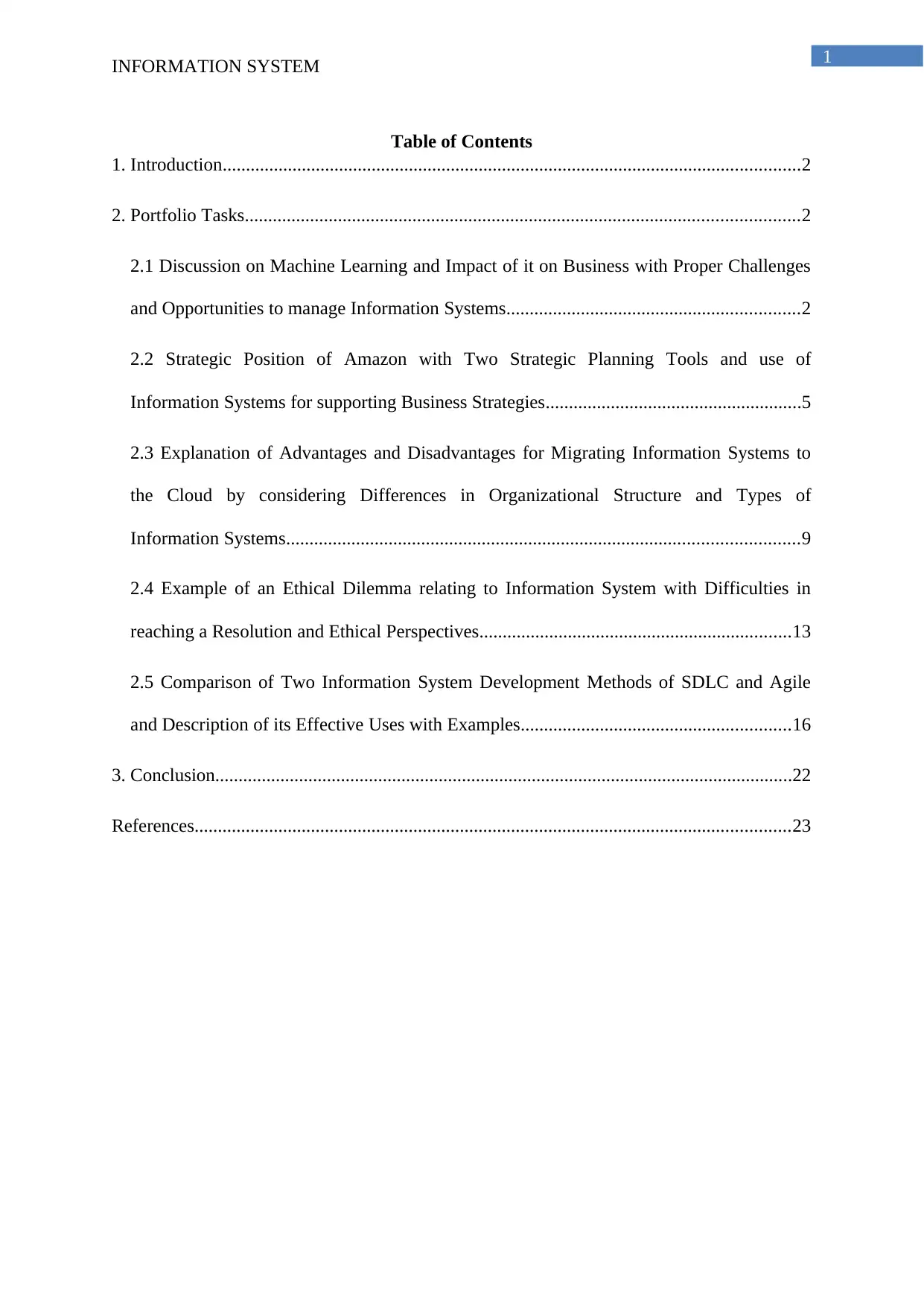
1
INFORMATION SYSTEM
Table of Contents
1. Introduction............................................................................................................................2
2. Portfolio Tasks.......................................................................................................................2
2.1 Discussion on Machine Learning and Impact of it on Business with Proper Challenges
and Opportunities to manage Information Systems...............................................................2
2.2 Strategic Position of Amazon with Two Strategic Planning Tools and use of
Information Systems for supporting Business Strategies.......................................................5
2.3 Explanation of Advantages and Disadvantages for Migrating Information Systems to
the Cloud by considering Differences in Organizational Structure and Types of
Information Systems..............................................................................................................9
2.4 Example of an Ethical Dilemma relating to Information System with Difficulties in
reaching a Resolution and Ethical Perspectives...................................................................13
2.5 Comparison of Two Information System Development Methods of SDLC and Agile
and Description of its Effective Uses with Examples..........................................................16
3. Conclusion............................................................................................................................22
References................................................................................................................................23
INFORMATION SYSTEM
Table of Contents
1. Introduction............................................................................................................................2
2. Portfolio Tasks.......................................................................................................................2
2.1 Discussion on Machine Learning and Impact of it on Business with Proper Challenges
and Opportunities to manage Information Systems...............................................................2
2.2 Strategic Position of Amazon with Two Strategic Planning Tools and use of
Information Systems for supporting Business Strategies.......................................................5
2.3 Explanation of Advantages and Disadvantages for Migrating Information Systems to
the Cloud by considering Differences in Organizational Structure and Types of
Information Systems..............................................................................................................9
2.4 Example of an Ethical Dilemma relating to Information System with Difficulties in
reaching a Resolution and Ethical Perspectives...................................................................13
2.5 Comparison of Two Information System Development Methods of SDLC and Agile
and Description of its Effective Uses with Examples..........................................................16
3. Conclusion............................................................................................................................22
References................................................................................................................................23
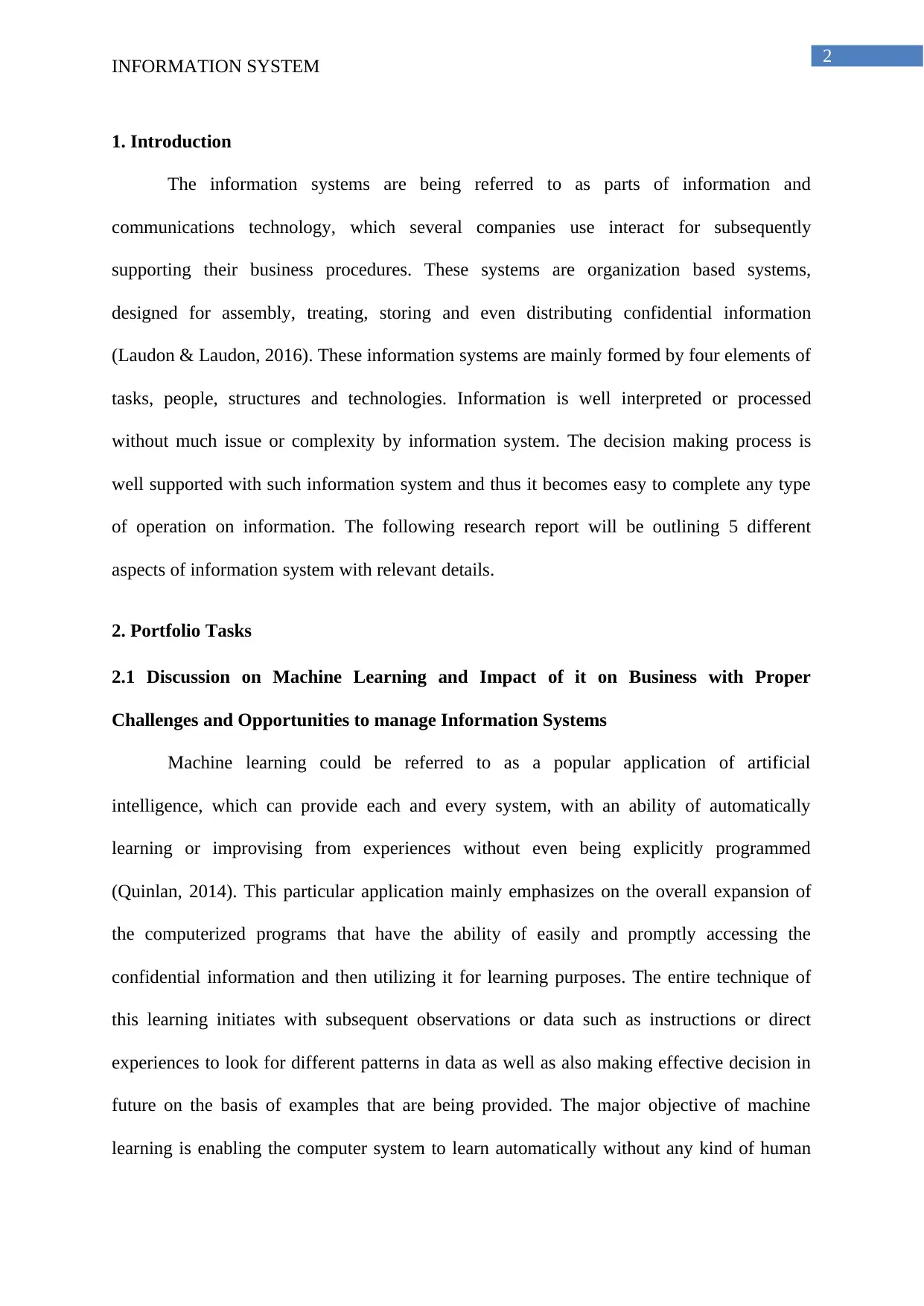
2
INFORMATION SYSTEM
1. Introduction
The information systems are being referred to as parts of information and
communications technology, which several companies use interact for subsequently
supporting their business procedures. These systems are organization based systems,
designed for assembly, treating, storing and even distributing confidential information
(Laudon & Laudon, 2016). These information systems are mainly formed by four elements of
tasks, people, structures and technologies. Information is well interpreted or processed
without much issue or complexity by information system. The decision making process is
well supported with such information system and thus it becomes easy to complete any type
of operation on information. The following research report will be outlining 5 different
aspects of information system with relevant details.
2. Portfolio Tasks
2.1 Discussion on Machine Learning and Impact of it on Business with Proper
Challenges and Opportunities to manage Information Systems
Machine learning could be referred to as a popular application of artificial
intelligence, which can provide each and every system, with an ability of automatically
learning or improvising from experiences without even being explicitly programmed
(Quinlan, 2014). This particular application mainly emphasizes on the overall expansion of
the computerized programs that have the ability of easily and promptly accessing the
confidential information and then utilizing it for learning purposes. The entire technique of
this learning initiates with subsequent observations or data such as instructions or direct
experiences to look for different patterns in data as well as also making effective decision in
future on the basis of examples that are being provided. The major objective of machine
learning is enabling the computer system to learn automatically without any kind of human
INFORMATION SYSTEM
1. Introduction
The information systems are being referred to as parts of information and
communications technology, which several companies use interact for subsequently
supporting their business procedures. These systems are organization based systems,
designed for assembly, treating, storing and even distributing confidential information
(Laudon & Laudon, 2016). These information systems are mainly formed by four elements of
tasks, people, structures and technologies. Information is well interpreted or processed
without much issue or complexity by information system. The decision making process is
well supported with such information system and thus it becomes easy to complete any type
of operation on information. The following research report will be outlining 5 different
aspects of information system with relevant details.
2. Portfolio Tasks
2.1 Discussion on Machine Learning and Impact of it on Business with Proper
Challenges and Opportunities to manage Information Systems
Machine learning could be referred to as a popular application of artificial
intelligence, which can provide each and every system, with an ability of automatically
learning or improvising from experiences without even being explicitly programmed
(Quinlan, 2014). This particular application mainly emphasizes on the overall expansion of
the computerized programs that have the ability of easily and promptly accessing the
confidential information and then utilizing it for learning purposes. The entire technique of
this learning initiates with subsequent observations or data such as instructions or direct
experiences to look for different patterns in data as well as also making effective decision in
future on the basis of examples that are being provided. The major objective of machine
learning is enabling the computer system to learn automatically without any kind of human
⊘ This is a preview!⊘
Do you want full access?
Subscribe today to unlock all pages.

Trusted by 1+ million students worldwide
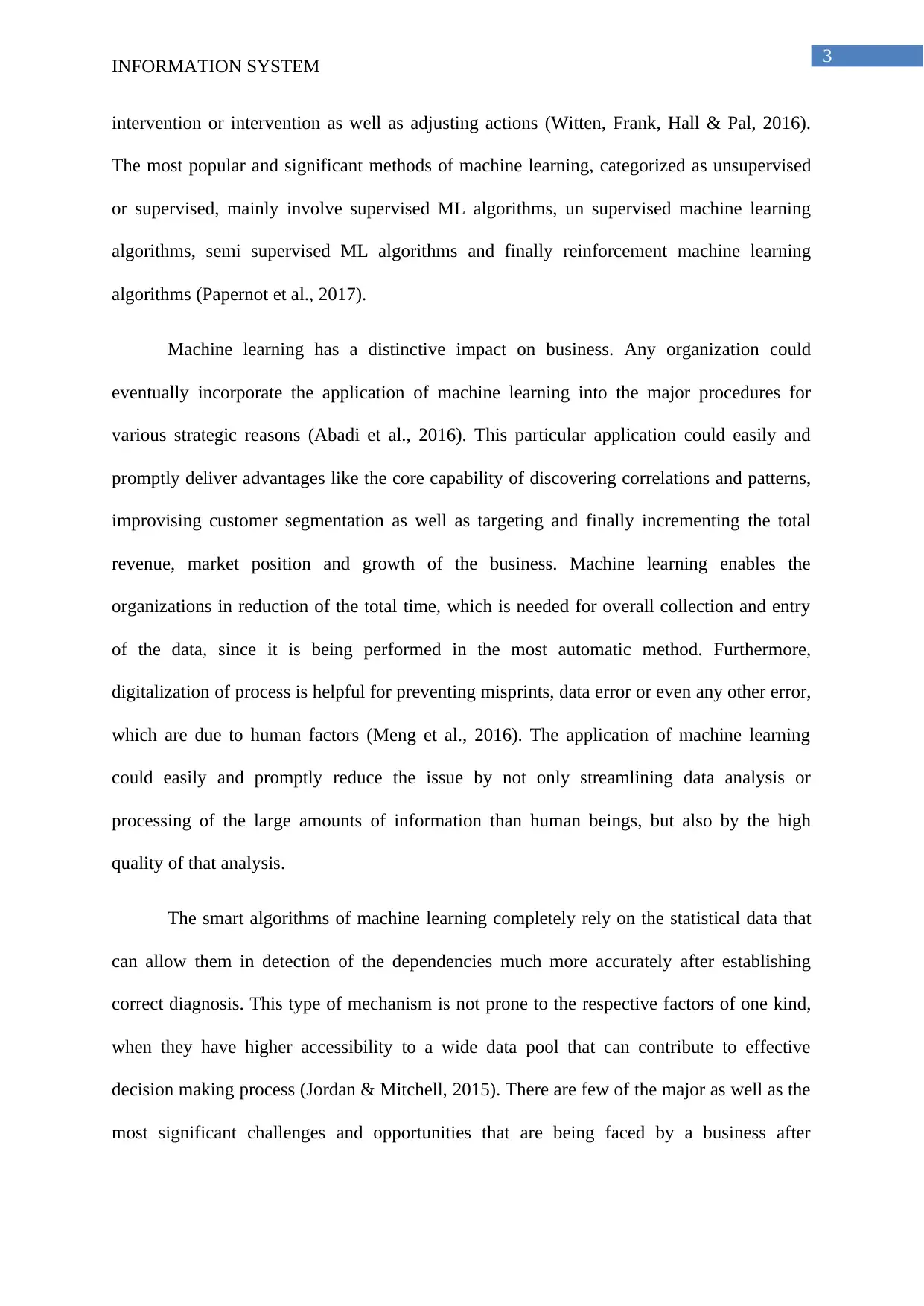
3
INFORMATION SYSTEM
intervention or intervention as well as adjusting actions (Witten, Frank, Hall & Pal, 2016).
The most popular and significant methods of machine learning, categorized as unsupervised
or supervised, mainly involve supervised ML algorithms, un supervised machine learning
algorithms, semi supervised ML algorithms and finally reinforcement machine learning
algorithms (Papernot et al., 2017).
Machine learning has a distinctive impact on business. Any organization could
eventually incorporate the application of machine learning into the major procedures for
various strategic reasons (Abadi et al., 2016). This particular application could easily and
promptly deliver advantages like the core capability of discovering correlations and patterns,
improvising customer segmentation as well as targeting and finally incrementing the total
revenue, market position and growth of the business. Machine learning enables the
organizations in reduction of the total time, which is needed for overall collection and entry
of the data, since it is being performed in the most automatic method. Furthermore,
digitalization of process is helpful for preventing misprints, data error or even any other error,
which are due to human factors (Meng et al., 2016). The application of machine learning
could easily and promptly reduce the issue by not only streamlining data analysis or
processing of the large amounts of information than human beings, but also by the high
quality of that analysis.
The smart algorithms of machine learning completely rely on the statistical data that
can allow them in detection of the dependencies much more accurately after establishing
correct diagnosis. This type of mechanism is not prone to the respective factors of one kind,
when they have higher accessibility to a wide data pool that can contribute to effective
decision making process (Jordan & Mitchell, 2015). There are few of the major as well as the
most significant challenges and opportunities that are being faced by a business after
INFORMATION SYSTEM
intervention or intervention as well as adjusting actions (Witten, Frank, Hall & Pal, 2016).
The most popular and significant methods of machine learning, categorized as unsupervised
or supervised, mainly involve supervised ML algorithms, un supervised machine learning
algorithms, semi supervised ML algorithms and finally reinforcement machine learning
algorithms (Papernot et al., 2017).
Machine learning has a distinctive impact on business. Any organization could
eventually incorporate the application of machine learning into the major procedures for
various strategic reasons (Abadi et al., 2016). This particular application could easily and
promptly deliver advantages like the core capability of discovering correlations and patterns,
improvising customer segmentation as well as targeting and finally incrementing the total
revenue, market position and growth of the business. Machine learning enables the
organizations in reduction of the total time, which is needed for overall collection and entry
of the data, since it is being performed in the most automatic method. Furthermore,
digitalization of process is helpful for preventing misprints, data error or even any other error,
which are due to human factors (Meng et al., 2016). The application of machine learning
could easily and promptly reduce the issue by not only streamlining data analysis or
processing of the large amounts of information than human beings, but also by the high
quality of that analysis.
The smart algorithms of machine learning completely rely on the statistical data that
can allow them in detection of the dependencies much more accurately after establishing
correct diagnosis. This type of mechanism is not prone to the respective factors of one kind,
when they have higher accessibility to a wide data pool that can contribute to effective
decision making process (Jordan & Mitchell, 2015). There are few of the major as well as the
most significant challenges and opportunities that are being faced by a business after
Paraphrase This Document
Need a fresh take? Get an instant paraphrase of this document with our AI Paraphraser
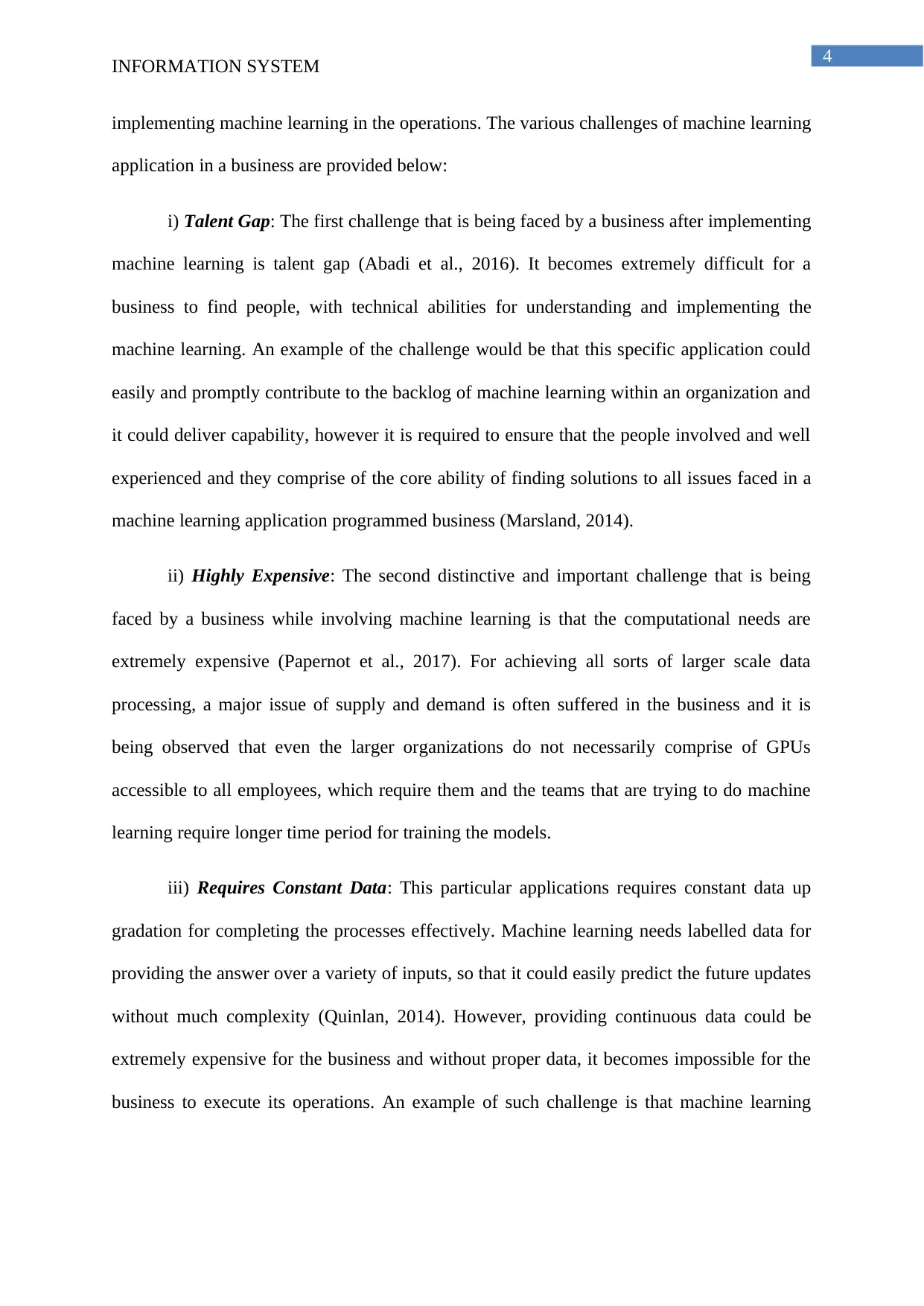
4
INFORMATION SYSTEM
implementing machine learning in the operations. The various challenges of machine learning
application in a business are provided below:
i) Talent Gap: The first challenge that is being faced by a business after implementing
machine learning is talent gap (Abadi et al., 2016). It becomes extremely difficult for a
business to find people, with technical abilities for understanding and implementing the
machine learning. An example of the challenge would be that this specific application could
easily and promptly contribute to the backlog of machine learning within an organization and
it could deliver capability, however it is required to ensure that the people involved and well
experienced and they comprise of the core ability of finding solutions to all issues faced in a
machine learning application programmed business (Marsland, 2014).
ii) Highly Expensive: The second distinctive and important challenge that is being
faced by a business while involving machine learning is that the computational needs are
extremely expensive (Papernot et al., 2017). For achieving all sorts of larger scale data
processing, a major issue of supply and demand is often suffered in the business and it is
being observed that even the larger organizations do not necessarily comprise of GPUs
accessible to all employees, which require them and the teams that are trying to do machine
learning require longer time period for training the models.
iii) Requires Constant Data: This particular applications requires constant data up
gradation for completing the processes effectively. Machine learning needs labelled data for
providing the answer over a variety of inputs, so that it could easily predict the future updates
without much complexity (Quinlan, 2014). However, providing continuous data could be
extremely expensive for the business and without proper data, it becomes impossible for the
business to execute its operations. An example of such challenge is that machine learning
INFORMATION SYSTEM
implementing machine learning in the operations. The various challenges of machine learning
application in a business are provided below:
i) Talent Gap: The first challenge that is being faced by a business after implementing
machine learning is talent gap (Abadi et al., 2016). It becomes extremely difficult for a
business to find people, with technical abilities for understanding and implementing the
machine learning. An example of the challenge would be that this specific application could
easily and promptly contribute to the backlog of machine learning within an organization and
it could deliver capability, however it is required to ensure that the people involved and well
experienced and they comprise of the core ability of finding solutions to all issues faced in a
machine learning application programmed business (Marsland, 2014).
ii) Highly Expensive: The second distinctive and important challenge that is being
faced by a business while involving machine learning is that the computational needs are
extremely expensive (Papernot et al., 2017). For achieving all sorts of larger scale data
processing, a major issue of supply and demand is often suffered in the business and it is
being observed that even the larger organizations do not necessarily comprise of GPUs
accessible to all employees, which require them and the teams that are trying to do machine
learning require longer time period for training the models.
iii) Requires Constant Data: This particular applications requires constant data up
gradation for completing the processes effectively. Machine learning needs labelled data for
providing the answer over a variety of inputs, so that it could easily predict the future updates
without much complexity (Quinlan, 2014). However, providing continuous data could be
extremely expensive for the business and without proper data, it becomes impossible for the
business to execute its operations. An example of such challenge is that machine learning

5
INFORMATION SYSTEM
needs more data and it becomes extremely difficult to provide proper solutions without this
data.
In spite of having such distinctive challenges, there are few opportunities as well that
are being provided by machine learning, which are as follows:
i) High Security: Machine learning is responsible for providing high data security in
any business and hence the respective organization does not face any type of complexity,
after reduction of cyber security attacks (Abadi et al., 2016). One of the most significant
examples of this opportunity is that hackers could not get any opportunity to hack data and
potential risks to data are minimized to a high level. It could even make better predictions
with time and help to automate the tasks efficiently.
ii) Provides Advantages in Marketing and Sales: Machine learning helps businesses
in finding the most valuable customers and also in identification or gaining new prospects.
The tools of this application perfectly compasses the business in reaching to the customers
(Jordan & Mitchell, 2015). An example of this type of opportunity would be that the data
driven insights help in enabling sales people in obtaining better sales and incrementing
performances.
iii) Better Customer Services: Customers get the opportunity to connect to the
business directly and without involving any complexity in the process. Machine learning
provides chatbot that can use workflows with several features for building a resourceful bot.
These chatbots can understand intents of customers and hence issues related to customer
satisfaction is being resolved effectively (Marsland, 2014). The most significant example of
his opportunity is that it provides conversational AI machine, which makes the bot
conversation looks more like human beings.
INFORMATION SYSTEM
needs more data and it becomes extremely difficult to provide proper solutions without this
data.
In spite of having such distinctive challenges, there are few opportunities as well that
are being provided by machine learning, which are as follows:
i) High Security: Machine learning is responsible for providing high data security in
any business and hence the respective organization does not face any type of complexity,
after reduction of cyber security attacks (Abadi et al., 2016). One of the most significant
examples of this opportunity is that hackers could not get any opportunity to hack data and
potential risks to data are minimized to a high level. It could even make better predictions
with time and help to automate the tasks efficiently.
ii) Provides Advantages in Marketing and Sales: Machine learning helps businesses
in finding the most valuable customers and also in identification or gaining new prospects.
The tools of this application perfectly compasses the business in reaching to the customers
(Jordan & Mitchell, 2015). An example of this type of opportunity would be that the data
driven insights help in enabling sales people in obtaining better sales and incrementing
performances.
iii) Better Customer Services: Customers get the opportunity to connect to the
business directly and without involving any complexity in the process. Machine learning
provides chatbot that can use workflows with several features for building a resourceful bot.
These chatbots can understand intents of customers and hence issues related to customer
satisfaction is being resolved effectively (Marsland, 2014). The most significant example of
his opportunity is that it provides conversational AI machine, which makes the bot
conversation looks more like human beings.
⊘ This is a preview!⊘
Do you want full access?
Subscribe today to unlock all pages.

Trusted by 1+ million students worldwide
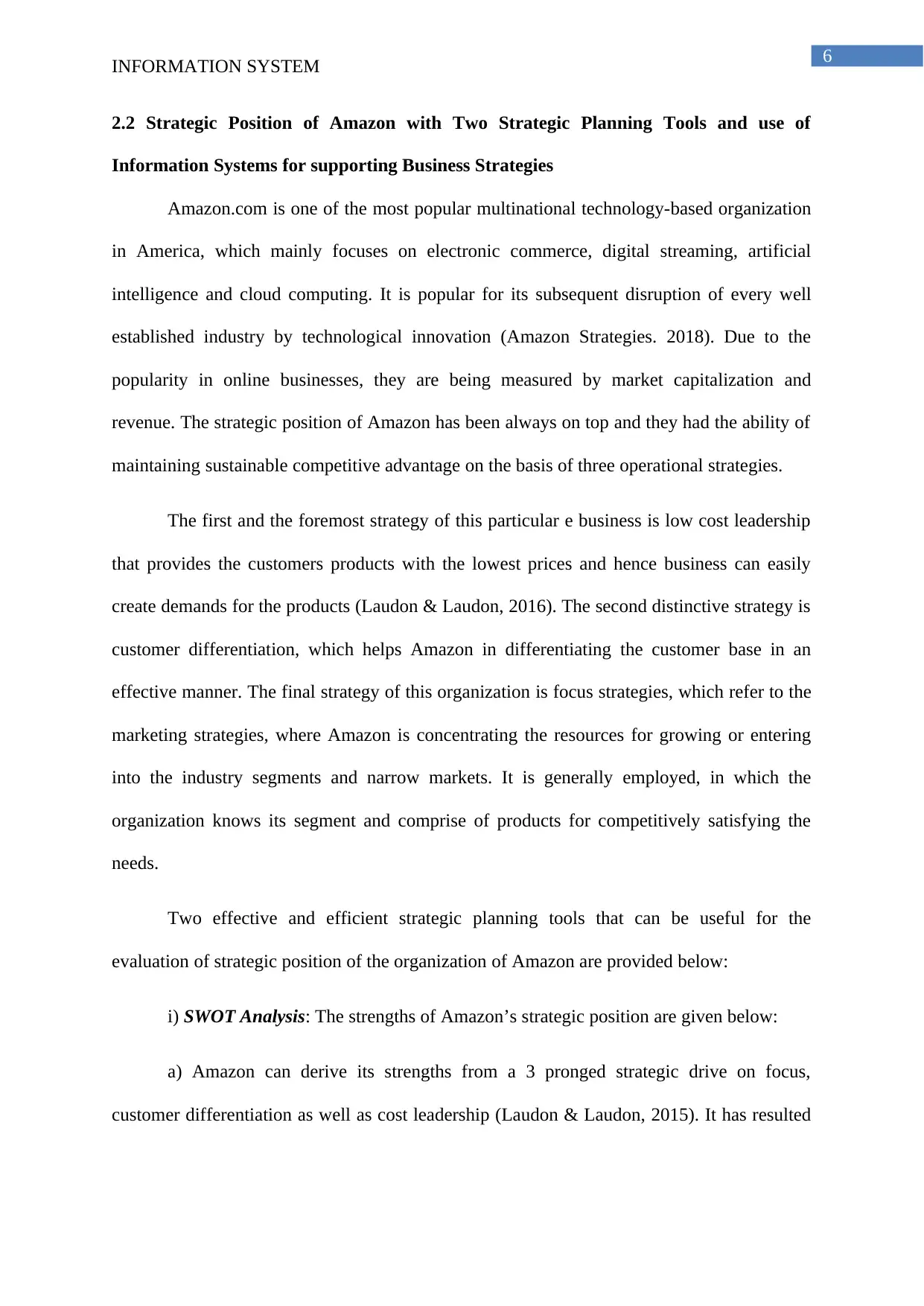
6
INFORMATION SYSTEM
2.2 Strategic Position of Amazon with Two Strategic Planning Tools and use of
Information Systems for supporting Business Strategies
Amazon.com is one of the most popular multinational technology-based organization
in America, which mainly focuses on electronic commerce, digital streaming, artificial
intelligence and cloud computing. It is popular for its subsequent disruption of every well
established industry by technological innovation (Amazon Strategies. 2018). Due to the
popularity in online businesses, they are being measured by market capitalization and
revenue. The strategic position of Amazon has been always on top and they had the ability of
maintaining sustainable competitive advantage on the basis of three operational strategies.
The first and the foremost strategy of this particular e business is low cost leadership
that provides the customers products with the lowest prices and hence business can easily
create demands for the products (Laudon & Laudon, 2016). The second distinctive strategy is
customer differentiation, which helps Amazon in differentiating the customer base in an
effective manner. The final strategy of this organization is focus strategies, which refer to the
marketing strategies, where Amazon is concentrating the resources for growing or entering
into the industry segments and narrow markets. It is generally employed, in which the
organization knows its segment and comprise of products for competitively satisfying the
needs.
Two effective and efficient strategic planning tools that can be useful for the
evaluation of strategic position of the organization of Amazon are provided below:
i) SWOT Analysis: The strengths of Amazon’s strategic position are given below:
a) Amazon can derive its strengths from a 3 pronged strategic drive on focus,
customer differentiation as well as cost leadership (Laudon & Laudon, 2015). It has resulted
INFORMATION SYSTEM
2.2 Strategic Position of Amazon with Two Strategic Planning Tools and use of
Information Systems for supporting Business Strategies
Amazon.com is one of the most popular multinational technology-based organization
in America, which mainly focuses on electronic commerce, digital streaming, artificial
intelligence and cloud computing. It is popular for its subsequent disruption of every well
established industry by technological innovation (Amazon Strategies. 2018). Due to the
popularity in online businesses, they are being measured by market capitalization and
revenue. The strategic position of Amazon has been always on top and they had the ability of
maintaining sustainable competitive advantage on the basis of three operational strategies.
The first and the foremost strategy of this particular e business is low cost leadership
that provides the customers products with the lowest prices and hence business can easily
create demands for the products (Laudon & Laudon, 2016). The second distinctive strategy is
customer differentiation, which helps Amazon in differentiating the customer base in an
effective manner. The final strategy of this organization is focus strategies, which refer to the
marketing strategies, where Amazon is concentrating the resources for growing or entering
into the industry segments and narrow markets. It is generally employed, in which the
organization knows its segment and comprise of products for competitively satisfying the
needs.
Two effective and efficient strategic planning tools that can be useful for the
evaluation of strategic position of the organization of Amazon are provided below:
i) SWOT Analysis: The strengths of Amazon’s strategic position are given below:
a) Amazon can derive its strengths from a 3 pronged strategic drive on focus,
customer differentiation as well as cost leadership (Laudon & Laudon, 2015). It has resulted
Paraphrase This Document
Need a fresh take? Get an instant paraphrase of this document with our AI Paraphraser
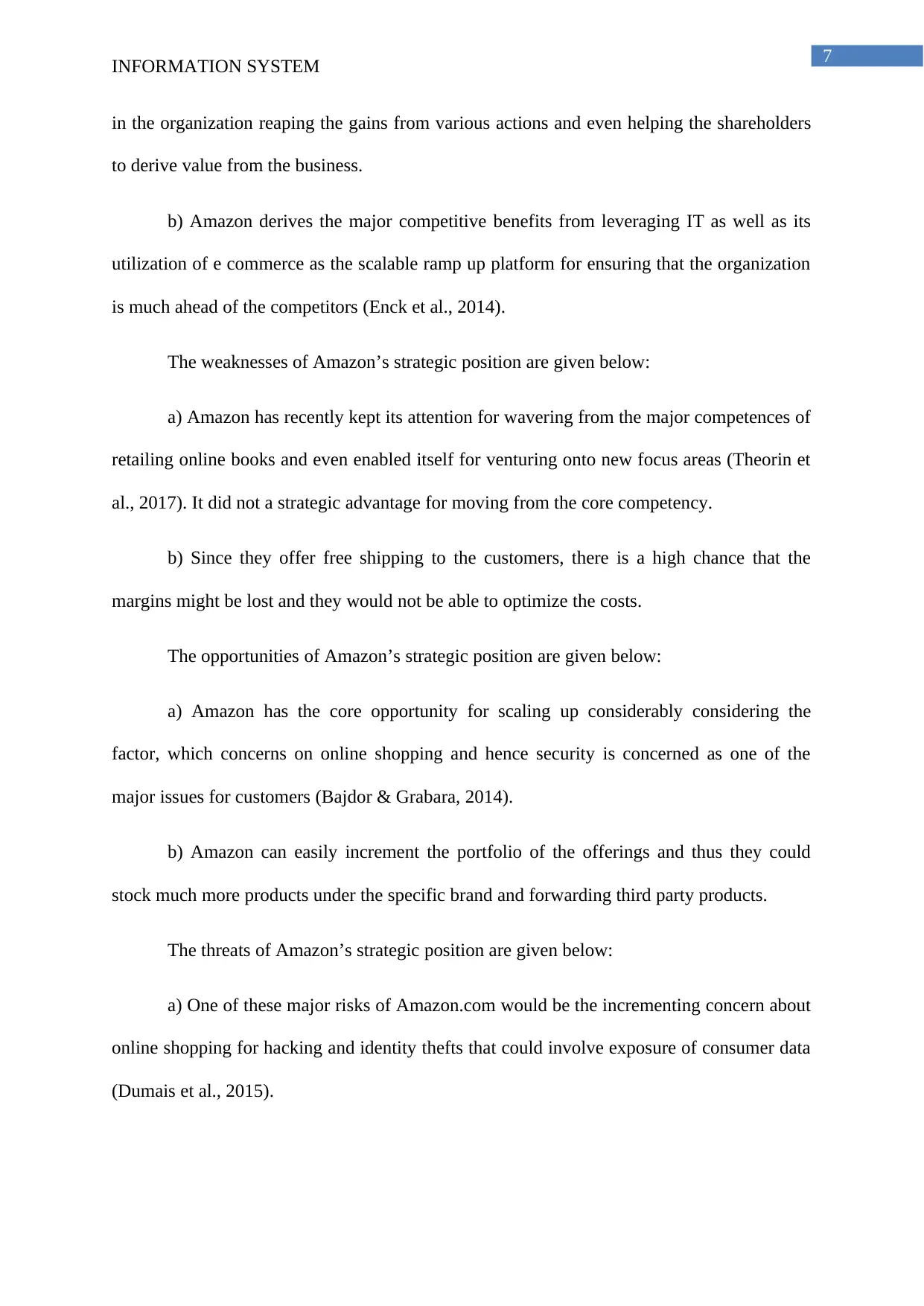
7
INFORMATION SYSTEM
in the organization reaping the gains from various actions and even helping the shareholders
to derive value from the business.
b) Amazon derives the major competitive benefits from leveraging IT as well as its
utilization of e commerce as the scalable ramp up platform for ensuring that the organization
is much ahead of the competitors (Enck et al., 2014).
The weaknesses of Amazon’s strategic position are given below:
a) Amazon has recently kept its attention for wavering from the major competences of
retailing online books and even enabled itself for venturing onto new focus areas (Theorin et
al., 2017). It did not a strategic advantage for moving from the core competency.
b) Since they offer free shipping to the customers, there is a high chance that the
margins might be lost and they would not be able to optimize the costs.
The opportunities of Amazon’s strategic position are given below:
a) Amazon has the core opportunity for scaling up considerably considering the
factor, which concerns on online shopping and hence security is concerned as one of the
major issues for customers (Bajdor & Grabara, 2014).
b) Amazon can easily increment the portfolio of the offerings and thus they could
stock much more products under the specific brand and forwarding third party products.
The threats of Amazon’s strategic position are given below:
a) One of these major risks of Amazon.com would be the incrementing concern about
online shopping for hacking and identity thefts that could involve exposure of consumer data
(Dumais et al., 2015).
INFORMATION SYSTEM
in the organization reaping the gains from various actions and even helping the shareholders
to derive value from the business.
b) Amazon derives the major competitive benefits from leveraging IT as well as its
utilization of e commerce as the scalable ramp up platform for ensuring that the organization
is much ahead of the competitors (Enck et al., 2014).
The weaknesses of Amazon’s strategic position are given below:
a) Amazon has recently kept its attention for wavering from the major competences of
retailing online books and even enabled itself for venturing onto new focus areas (Theorin et
al., 2017). It did not a strategic advantage for moving from the core competency.
b) Since they offer free shipping to the customers, there is a high chance that the
margins might be lost and they would not be able to optimize the costs.
The opportunities of Amazon’s strategic position are given below:
a) Amazon has the core opportunity for scaling up considerably considering the
factor, which concerns on online shopping and hence security is concerned as one of the
major issues for customers (Bajdor & Grabara, 2014).
b) Amazon can easily increment the portfolio of the offerings and thus they could
stock much more products under the specific brand and forwarding third party products.
The threats of Amazon’s strategic position are given below:
a) One of these major risks of Amazon.com would be the incrementing concern about
online shopping for hacking and identity thefts that could involve exposure of consumer data
(Dumais et al., 2015).
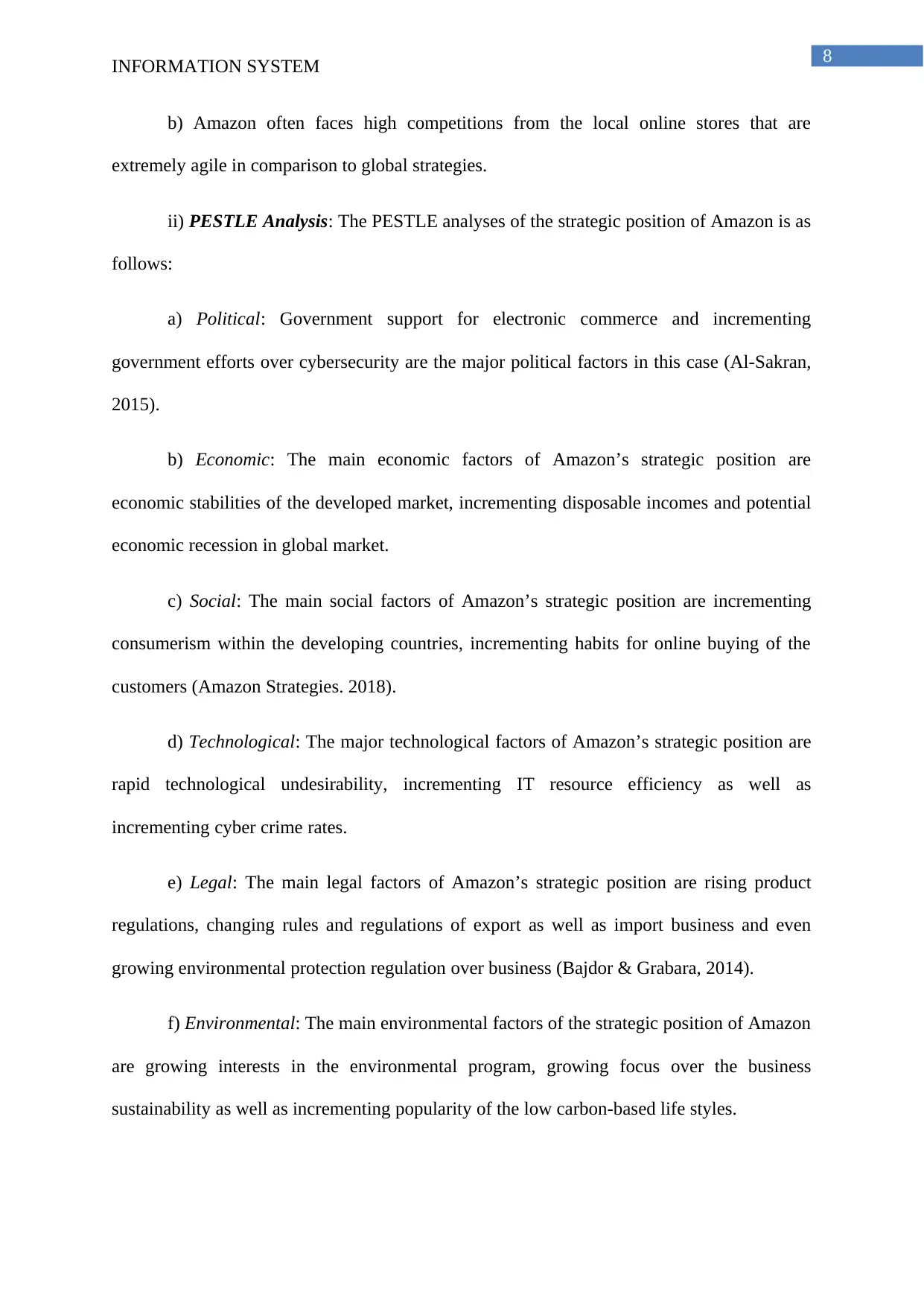
8
INFORMATION SYSTEM
b) Amazon often faces high competitions from the local online stores that are
extremely agile in comparison to global strategies.
ii) PESTLE Analysis: The PESTLE analyses of the strategic position of Amazon is as
follows:
a) Political: Government support for electronic commerce and incrementing
government efforts over cybersecurity are the major political factors in this case (Al-Sakran,
2015).
b) Economic: The main economic factors of Amazon’s strategic position are
economic stabilities of the developed market, incrementing disposable incomes and potential
economic recession in global market.
c) Social: The main social factors of Amazon’s strategic position are incrementing
consumerism within the developing countries, incrementing habits for online buying of the
customers (Amazon Strategies. 2018).
d) Technological: The major technological factors of Amazon’s strategic position are
rapid technological undesirability, incrementing IT resource efficiency as well as
incrementing cyber crime rates.
e) Legal: The main legal factors of Amazon’s strategic position are rising product
regulations, changing rules and regulations of export as well as import business and even
growing environmental protection regulation over business (Bajdor & Grabara, 2014).
f) Environmental: The main environmental factors of the strategic position of Amazon
are growing interests in the environmental program, growing focus over the business
sustainability as well as incrementing popularity of the low carbon-based life styles.
INFORMATION SYSTEM
b) Amazon often faces high competitions from the local online stores that are
extremely agile in comparison to global strategies.
ii) PESTLE Analysis: The PESTLE analyses of the strategic position of Amazon is as
follows:
a) Political: Government support for electronic commerce and incrementing
government efforts over cybersecurity are the major political factors in this case (Al-Sakran,
2015).
b) Economic: The main economic factors of Amazon’s strategic position are
economic stabilities of the developed market, incrementing disposable incomes and potential
economic recession in global market.
c) Social: The main social factors of Amazon’s strategic position are incrementing
consumerism within the developing countries, incrementing habits for online buying of the
customers (Amazon Strategies. 2018).
d) Technological: The major technological factors of Amazon’s strategic position are
rapid technological undesirability, incrementing IT resource efficiency as well as
incrementing cyber crime rates.
e) Legal: The main legal factors of Amazon’s strategic position are rising product
regulations, changing rules and regulations of export as well as import business and even
growing environmental protection regulation over business (Bajdor & Grabara, 2014).
f) Environmental: The main environmental factors of the strategic position of Amazon
are growing interests in the environmental program, growing focus over the business
sustainability as well as incrementing popularity of the low carbon-based life styles.
⊘ This is a preview!⊘
Do you want full access?
Subscribe today to unlock all pages.

Trusted by 1+ million students worldwide
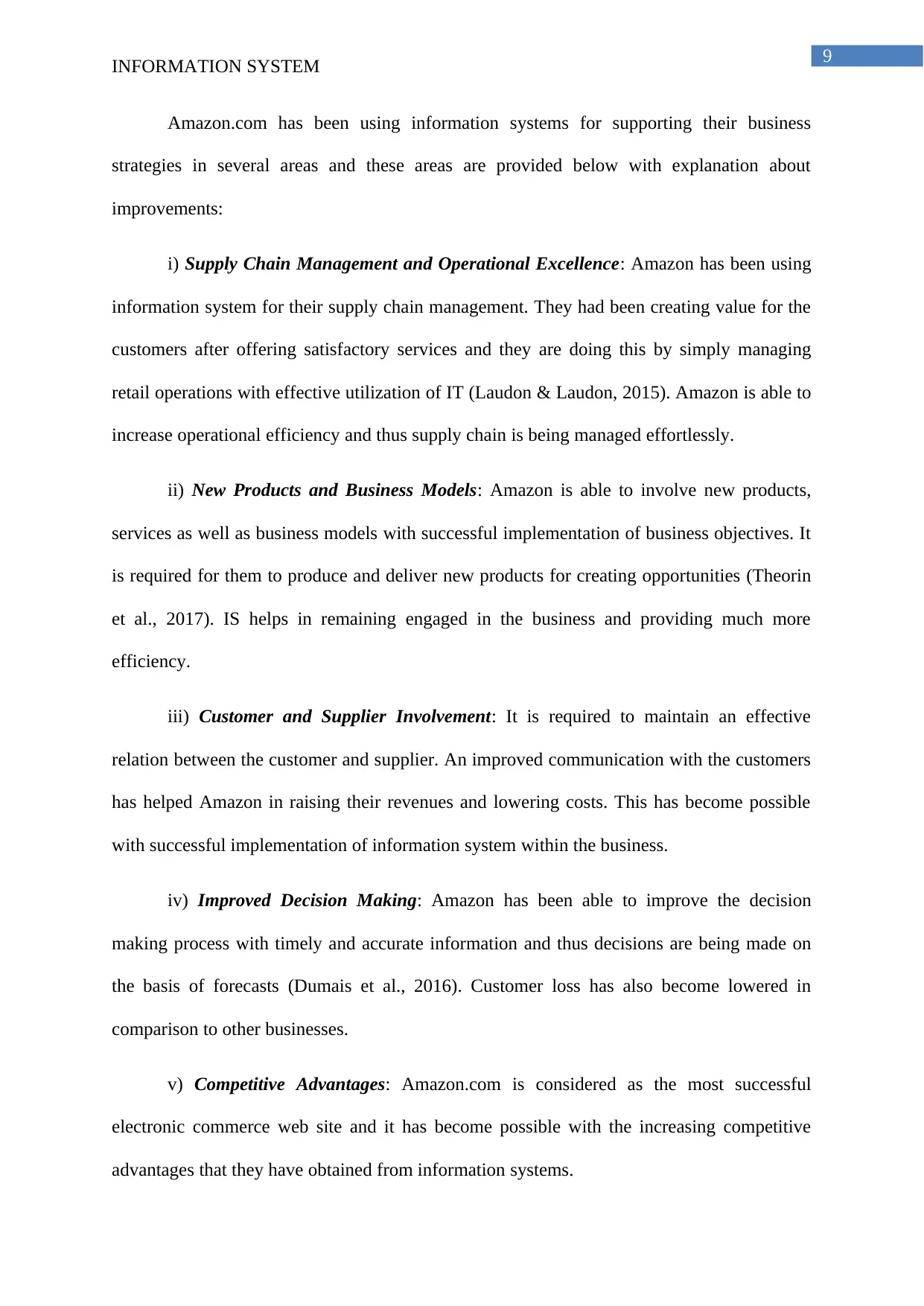
9
INFORMATION SYSTEM
Amazon.com has been using information systems for supporting their business
strategies in several areas and these areas are provided below with explanation about
improvements:
i) Supply Chain Management and Operational Excellence: Amazon has been using
information system for their supply chain management. They had been creating value for the
customers after offering satisfactory services and they are doing this by simply managing
retail operations with effective utilization of IT (Laudon & Laudon, 2015). Amazon is able to
increase operational efficiency and thus supply chain is being managed effortlessly.
ii) New Products and Business Models: Amazon is able to involve new products,
services as well as business models with successful implementation of business objectives. It
is required for them to produce and deliver new products for creating opportunities (Theorin
et al., 2017). IS helps in remaining engaged in the business and providing much more
efficiency.
iii) Customer and Supplier Involvement: It is required to maintain an effective
relation between the customer and supplier. An improved communication with the customers
has helped Amazon in raising their revenues and lowering costs. This has become possible
with successful implementation of information system within the business.
iv) Improved Decision Making: Amazon has been able to improve the decision
making process with timely and accurate information and thus decisions are being made on
the basis of forecasts (Dumais et al., 2016). Customer loss has also become lowered in
comparison to other businesses.
v) Competitive Advantages: Amazon.com is considered as the most successful
electronic commerce web site and it has become possible with the increasing competitive
advantages that they have obtained from information systems.
INFORMATION SYSTEM
Amazon.com has been using information systems for supporting their business
strategies in several areas and these areas are provided below with explanation about
improvements:
i) Supply Chain Management and Operational Excellence: Amazon has been using
information system for their supply chain management. They had been creating value for the
customers after offering satisfactory services and they are doing this by simply managing
retail operations with effective utilization of IT (Laudon & Laudon, 2015). Amazon is able to
increase operational efficiency and thus supply chain is being managed effortlessly.
ii) New Products and Business Models: Amazon is able to involve new products,
services as well as business models with successful implementation of business objectives. It
is required for them to produce and deliver new products for creating opportunities (Theorin
et al., 2017). IS helps in remaining engaged in the business and providing much more
efficiency.
iii) Customer and Supplier Involvement: It is required to maintain an effective
relation between the customer and supplier. An improved communication with the customers
has helped Amazon in raising their revenues and lowering costs. This has become possible
with successful implementation of information system within the business.
iv) Improved Decision Making: Amazon has been able to improve the decision
making process with timely and accurate information and thus decisions are being made on
the basis of forecasts (Dumais et al., 2016). Customer loss has also become lowered in
comparison to other businesses.
v) Competitive Advantages: Amazon.com is considered as the most successful
electronic commerce web site and it has become possible with the increasing competitive
advantages that they have obtained from information systems.
Paraphrase This Document
Need a fresh take? Get an instant paraphrase of this document with our AI Paraphraser
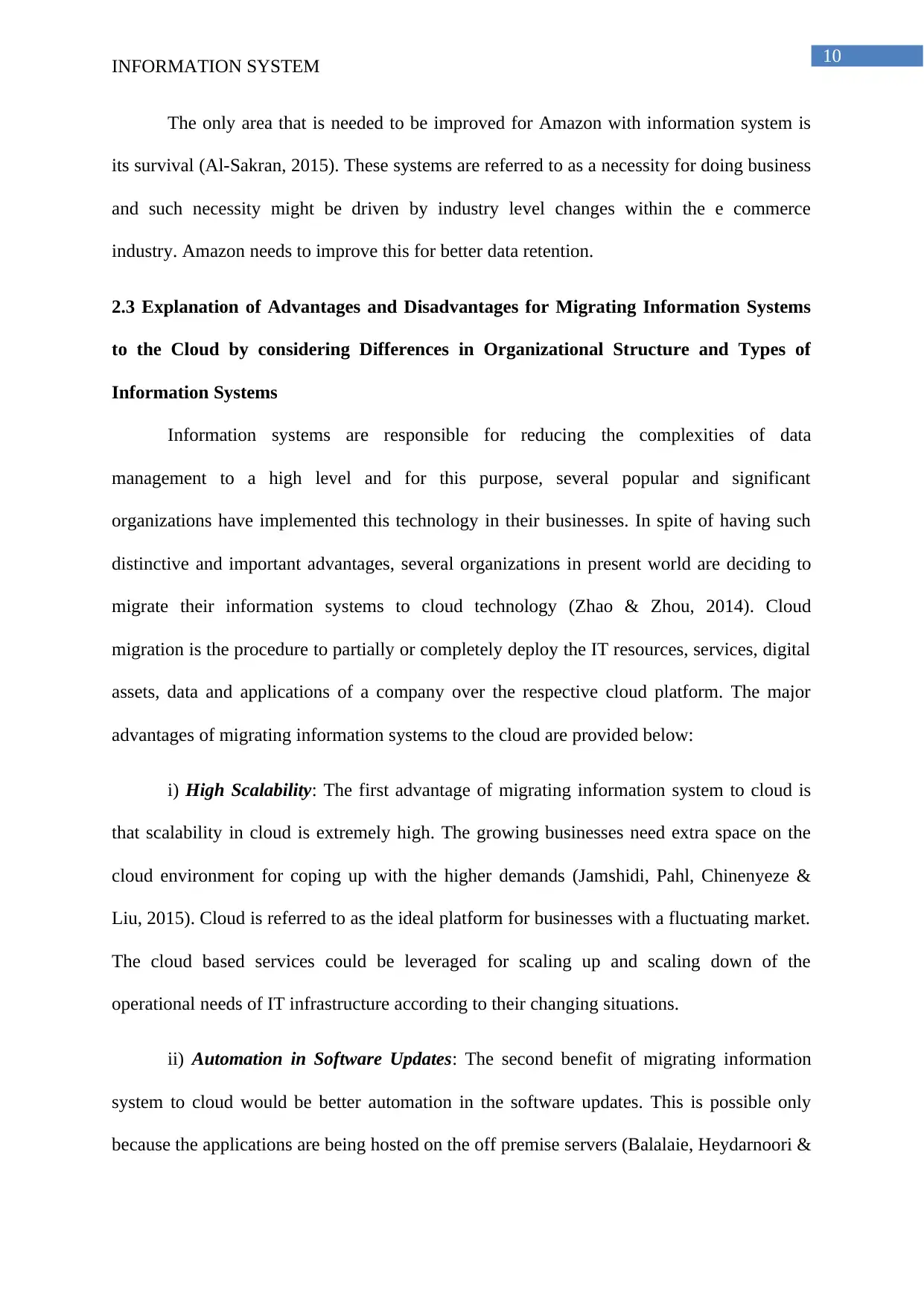
10
INFORMATION SYSTEM
The only area that is needed to be improved for Amazon with information system is
its survival (Al-Sakran, 2015). These systems are referred to as a necessity for doing business
and such necessity might be driven by industry level changes within the e commerce
industry. Amazon needs to improve this for better data retention.
2.3 Explanation of Advantages and Disadvantages for Migrating Information Systems
to the Cloud by considering Differences in Organizational Structure and Types of
Information Systems
Information systems are responsible for reducing the complexities of data
management to a high level and for this purpose, several popular and significant
organizations have implemented this technology in their businesses. In spite of having such
distinctive and important advantages, several organizations in present world are deciding to
migrate their information systems to cloud technology (Zhao & Zhou, 2014). Cloud
migration is the procedure to partially or completely deploy the IT resources, services, digital
assets, data and applications of a company over the respective cloud platform. The major
advantages of migrating information systems to the cloud are provided below:
i) High Scalability: The first advantage of migrating information system to cloud is
that scalability in cloud is extremely high. The growing businesses need extra space on the
cloud environment for coping up with the higher demands (Jamshidi, Pahl, Chinenyeze &
Liu, 2015). Cloud is referred to as the ideal platform for businesses with a fluctuating market.
The cloud based services could be leveraged for scaling up and scaling down of the
operational needs of IT infrastructure according to their changing situations.
ii) Automation in Software Updates: The second benefit of migrating information
system to cloud would be better automation in the software updates. This is possible only
because the applications are being hosted on the off premise servers (Balalaie, Heydarnoori &
INFORMATION SYSTEM
The only area that is needed to be improved for Amazon with information system is
its survival (Al-Sakran, 2015). These systems are referred to as a necessity for doing business
and such necessity might be driven by industry level changes within the e commerce
industry. Amazon needs to improve this for better data retention.
2.3 Explanation of Advantages and Disadvantages for Migrating Information Systems
to the Cloud by considering Differences in Organizational Structure and Types of
Information Systems
Information systems are responsible for reducing the complexities of data
management to a high level and for this purpose, several popular and significant
organizations have implemented this technology in their businesses. In spite of having such
distinctive and important advantages, several organizations in present world are deciding to
migrate their information systems to cloud technology (Zhao & Zhou, 2014). Cloud
migration is the procedure to partially or completely deploy the IT resources, services, digital
assets, data and applications of a company over the respective cloud platform. The major
advantages of migrating information systems to the cloud are provided below:
i) High Scalability: The first advantage of migrating information system to cloud is
that scalability in cloud is extremely high. The growing businesses need extra space on the
cloud environment for coping up with the higher demands (Jamshidi, Pahl, Chinenyeze &
Liu, 2015). Cloud is referred to as the ideal platform for businesses with a fluctuating market.
The cloud based services could be leveraged for scaling up and scaling down of the
operational needs of IT infrastructure according to their changing situations.
ii) Automation in Software Updates: The second benefit of migrating information
system to cloud would be better automation in the software updates. This is possible only
because the applications are being hosted on the off premise servers (Balalaie, Heydarnoori &

11
INFORMATION SYSTEM
Jamshidi, 2016). It helps in better maintenance of the IT infrastructure and cost is lowered to
a greater level.
iii) Lowered IT Costs: Cloud migration helps in lowering the IT costs and the
businesses could easily utilize the infrastructure and server capacity of the cloud service
provider only when the organizations ask for better usage of the third party IT resources like
infrastructure, server and hardware (Gholami, Daneshgar, Low & Beydoun, 2016). The
resources could be de-provisioned, if support is not required, thus reducing costs to a high
level.
iv) Disaster Recovery: Migration to cloud is also helpful in data protection as it is
referred to as the integral part of business continuity plan. The technology of cloud can take
up of backup of data at the most safe and secured location after protecting it from sudden
power failure or any other crisis.
v) Enhancement in Collaboration: Cloud migration is extremely helpful in
enhancing collaboration and the workforce is able to feel flexibility in utilization, editing and
sharing the documents and information within real time through shared storage (Rai, Sahoo &
Mehfuz, 2015). It allows the staff with virtual meetings with improvised collaboration,
development of products and customer services.
vi) Better Mobility: Cloud even provides better mobility to the business by providing
different types of cloud based data and applications so that data accessibility becomes much
easier in comparison to other technologies. The on field operations are well executed and it
provides better results to the clients.
Although, they comprise of several benefits, some of the disadvantages are also
present for migrating information systems to cloud and these disadvantages are provided
below:
INFORMATION SYSTEM
Jamshidi, 2016). It helps in better maintenance of the IT infrastructure and cost is lowered to
a greater level.
iii) Lowered IT Costs: Cloud migration helps in lowering the IT costs and the
businesses could easily utilize the infrastructure and server capacity of the cloud service
provider only when the organizations ask for better usage of the third party IT resources like
infrastructure, server and hardware (Gholami, Daneshgar, Low & Beydoun, 2016). The
resources could be de-provisioned, if support is not required, thus reducing costs to a high
level.
iv) Disaster Recovery: Migration to cloud is also helpful in data protection as it is
referred to as the integral part of business continuity plan. The technology of cloud can take
up of backup of data at the most safe and secured location after protecting it from sudden
power failure or any other crisis.
v) Enhancement in Collaboration: Cloud migration is extremely helpful in
enhancing collaboration and the workforce is able to feel flexibility in utilization, editing and
sharing the documents and information within real time through shared storage (Rai, Sahoo &
Mehfuz, 2015). It allows the staff with virtual meetings with improvised collaboration,
development of products and customer services.
vi) Better Mobility: Cloud even provides better mobility to the business by providing
different types of cloud based data and applications so that data accessibility becomes much
easier in comparison to other technologies. The on field operations are well executed and it
provides better results to the clients.
Although, they comprise of several benefits, some of the disadvantages are also
present for migrating information systems to cloud and these disadvantages are provided
below:
⊘ This is a preview!⊘
Do you want full access?
Subscribe today to unlock all pages.

Trusted by 1+ million students worldwide
1 out of 28
Related Documents
Your All-in-One AI-Powered Toolkit for Academic Success.
+13062052269
info@desklib.com
Available 24*7 on WhatsApp / Email
![[object Object]](/_next/static/media/star-bottom.7253800d.svg)
Unlock your academic potential
Copyright © 2020–2025 A2Z Services. All Rights Reserved. Developed and managed by ZUCOL.



